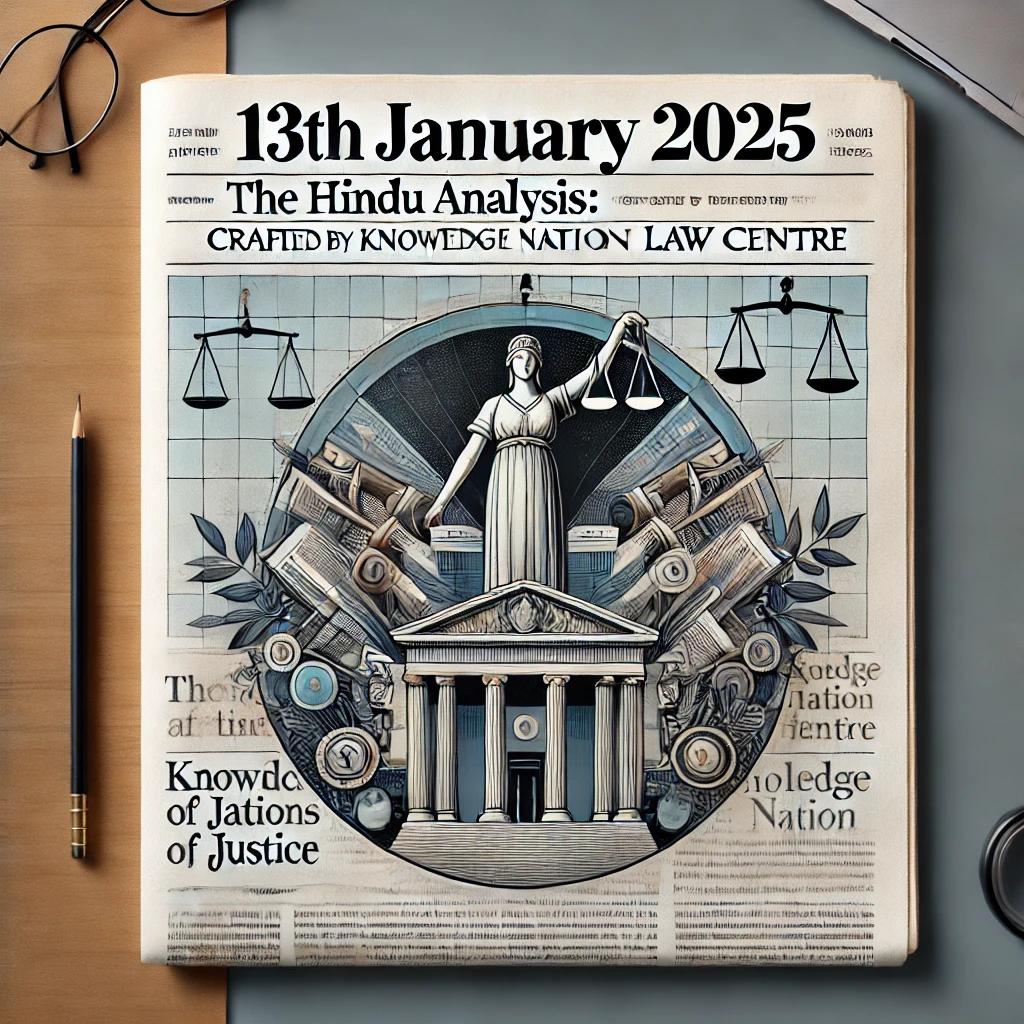13 January 2025: The Hindu Analysis (Daily Current Affairs)
Join WhatsApp community for Free Notifications, Updates, Study Material, Mock Tests, Internship Updates, and Current Affairs - CLICK HERE TO JOIN
1. Kerala’s maternal mortality ratio climbs as fertility levels fall to a new low
(Source – The Hindu, International Edition – Page No. – 1)
Topic: Social Justice – Health
Context
- Kerala is facing rising maternal mortality coupled with a falling birth rate, which is affecting the social fabric and demographic changes of the state.
Kerala’s Maternal Mortality Ratio (MMR)
- Kerala's MMR has risen from 19 to 29 per one lakh live births.
- This increase is not a result of more maternal deaths but rather fewer childbirths.
- The reduction in live births has led to a higher MMR.
- The state has seen a decline in births from 5-5. 5 lakh annually to 3. 93 lakh.
- During 2020-21, numerous maternal deaths were associated with COVID-19 among pregnant women.
Decline in Fertility Rate
- Kerala's fertility rate has been on a downward trend for over thirty years.
- In 1991, the fertility rate fell below the replacement level (2. 1 children per woman) and has remained between 1. 7 and 1. 8.
- By 2020, the total fertility rate (TFR) decreased to 1. 5 and currently stands at 1. 46.
- The TFR indicates that most couples in Kerala have one or no children.The state's declining birth rates have considerable social implications.
- Impact of Migration and Social Changes
To Enroll in Knowledge Nation Law Centre - Click Here
Impact of Migration and Social Changes
- A significant number of young individuals in Kerala migrate for employment or education, influencing fertility rates.
- Additionally, delayed marriage and childbearing are contributing factors to the drop in births.
- In the coming decade, Kerala's elderly population is expected to exceed that of children, raising concerns regarding care and welfare.
Challenges in Data Collection
- There are challenges in birth registration in Kerala, and official data on live births has not been publicly available since 2021.
Join WhatsApp community for Free Notifications, Updates, Study Material, Mock Tests, Internship Updates, and Current Affairs - CLICK HERE TO JOIN
2. Should voter IDs be linked with Aadhaar?
(Source – The Hindu, International Edition – Page No. – 10)
Topic: Indian Polity
Context
- The Aam Aadmi Party (AAP) and Bharatiya Janata Party (BJP) have accused one another of manipulating electoral rolls in the lead-up to the Delhi Assembly elections, reigniting the discussion regarding the linkage of voter IDs and Aadhaar numbers.
Background of the Proposal
- In February 2015, the Election Commission (EC) initiated the National Electoral Rolls Purification and Authentication Program (NERPAP) aimed at eliminating duplicate entries by linking voter IDs (EPIC) with Aadhaar.
- Within three months, over 300 million voters were linked. However, in August 2015, the Supreme Court intervened, ruling that Aadhaar could be used solely for welfare schemes and PAN linking, which halted the NERPAP.
- In December 2021, Parliament amended the Representation of the People Act, 1950, to permit the linking of Aadhaar with EPIC on a voluntary basis.
- Voters unable to provide Aadhaar can submit alternate documents such as PAN cards or bank passbook.
To Enroll in Knowledge Nation Law Centre - Click Here
Potential Implications:
- Challenges and Concerns: The Supreme Court was informed in September 2023 that providing Aadhaar numbers is not compulsory.
- Concerns exist regarding potential errors in the Aadhaar database that could lead to incorrect voter registrations or deletion of entries.
- Additionally, Aadhaar serves only as proof of residence, not citizenship, limiting its effectiveness in identifying non-citizens on the electoral rolls.
- Privacy concerns arise as the electoral roll is shared with political parties, raising the risk of misuse of Aadhaar information.
Pros and Cons
- Pros: Linking Aadhaar with EPIC aids in the elimination of duplicate voter entries, with over 650 million Aadhaar numbers already uploaded.
- Cons: Inaccuracies in the Aadhaar database could disrupt voter registration, and since Aadhaar does not confirm citizenship, its utility in removing non-citizens is constrained.
Way Forward
- Voting constitutes a constitutional right, making public trust in the electoral process essential.
- There should be heightened awareness regarding the advantages of linking Aadhaar to refine electoral rolls.
- Additionally, voter registration forms should be revised to clarify that Aadhaar submission is voluntary, aligning with the Supreme Court’s 2023 ruling.
Join WhatsApp community for Free Notifications, Updates, Study Material, Mock Tests, Internship Updates, and Current Affairs - CLICK HERE TO JOIN
3. UGC’s 2025 Draft Regulations Spark Federalism Debate Over VC Appointments
(Source – Indian Express, Section – Explained – Page No. – 16)
Topic: Governance
Context
- The article addresses the controversy surrounding the UGC’s 2025 draft regulations.
Analysis of the news:
VC Appointment Process: Current and Proposed Framework
- The University Grants Commission (UGC) regulations of 2018 required a search-cum-selection committee to shortlist candidates for Vice Chancellor (VC) positions through public notifications or nominations. For central universities, the President (Visitor) appoints VCs, while state laws govern the appointments for state universities, with significant involvement from Governors (Chancellors).
- The 2025 draft regulations propose that the Chancellor/Visitor establish the committee, which will consist of three expertsnominated by the Chancellor, UGC Chairman, and the university’s apex body. This represents a shift, increasing central influence and introducing the possibility of appointing industry or policy professionals as VCs.
State-Centre Disputes Over VC Appointments
Several states, particularly those governed by non-BJP parties, oppose the expanded role of Governors (Chancellors) in VC appointments:
- Kerala: Passed a Bill to replace the Governor with educationists as Chancellors, pending presidential assent.
- West Bengal: Legal disputes arose regarding the Governor’s unilateral appointments; the Assembly passed a Bill to designate the Chief Minister as the Chancellor.
- Karnataka: Legislation to replace the Governor with the Chief Minister as Chancellor is pending.
- Maharashtra: A 2021 Bill that aimed to reduce the Governor’s powers was withdrawn by the succeeding government.
- Tamil Nadu: Passed Bills to transfer VC appointment powers to the state government, awaiting Governor’s approval.
To Enroll in Knowledge Nation Law Centre - Click Here
Federalism at the Core of the Debate
- Critics, including the Chief Ministers of Kerala and Tamil Nadu, argue that the draft regulations undermine federalism by diminishing state autonomy over state university administration. They assert that this shift imposes central authority over state-run institutions and reduces the role of democratically elected governments. In contrast, UGC Chairman Jagadesh Kumar defends the regulations, highlighting their alignment with the National Education Policy (NEP) 2020 and addressing ambiguities in the 2018 guidelines.
Implications for Governance and Education
- The draft regulations aim to standardize VC selection, enhance transparency, and expand eligibility criteria. However, they also pose a risk of deepening state-Centre conflicts and raising concerns about the autonomy of state universities. Achieving a balance between quality governance in education and respecting federal principles will be essential as the debate progresses.
About Universal Grant Commission (UGC)
- The UGC was formally established in 1956 as a statutory body of the Government of India through the University Grants Commission Act of 1956. The head office of the UGC is located in New Delhi. The UGC's mandate includes:
The UGC`s mandate includes:
- Determining and maintaining standards of teaching, examination, and research in universities.
- Framing regulations on minimum standards of education, monitoring developments in collegiate and university education, and disbursing grants to universities and colleges.
- Advising the Central and State governments on necessary measures for improving university education.
Join WhatsApp community for Free Notifications, Updates, Study Material, Mock Tests, Internship Updates, and Current Affairs - CLICK HERE TO JOIN
Prelims Facts
1. An unlikely mystery: studies shed new light on how genes are made
(Source – The Hindu, International Edition – Page No. – 7)
Context
- Research conducted by the University of Nevada and Max Planck Institute examined the processes involved in gene formation, focusing on duplication, methylation, and random sequences.
How Genes Are Made: New Research Insights
Gene Duplication
- Gene duplication is a fundamental mechanism in the development of new genes.
- In gene duplication, one copy retains its original function while the other is liberated to mutate and acquire new functions.
- Researchers observed that duplicated genes exhibit increased levels of methylated DNA, which serves to mitigate excessive protein production.
To Enroll in Knowledge Nation Law Centre - Click Here
Methylation and Mutation
- Methylation involves the addition of a methyl group to a DNA molecule, influencing its functionality.
- Genes that are methylated tend to experience higher mutation rates, contributing to the diversity of genetic functions.
Exogenous DNA and Random Sequences
- Researchers introduced random DNA sequences into human cells to evaluate their impact.
- Certain random sequences promoted cell growth, resembling early-stage genes with potential for evolution.
Retaining Useful Genes
- For a gene to remain within the genome, it must provide a benefit or contribute to the organism's survival.
- Non-essential genes, such as those determining blood types, may lack obvious functions but persist due to evolutionary processes.
Conclusion
- These findings illustrate how new genes arise through duplication, mutations, and the retention of advantageous genetic modifications over time.
Join WhatsApp community for Free Notifications, Updates, Study Material, Mock Tests, Internship Updates, and Current Affairs - CLICK HERE TO JOIN
2. IMD: India’s weather tracker
(Source – The Hindu, International Edition – Page No. – 7)
Context
- The India Meteorological Department (IMD) will celebrate its 150th anniversary on January 15, 2025.
India Meteorological Department (IMD):
- The IMD was established in 1875 by the British government in India.
- Henry Francis Blanford was its first Meteorological Reporter.
- The IMD was created due to the importance of monsoons and cyclones in South Asia.
- The 1864 Calcutta cyclone and the Orissa famine in 1866 led to the formation of the IMD.
To Enroll in Knowledge Nation Law Centre - Click Here
- Initially based in Calcutta, the IMD moved to New Delhi in 1944.
- After India’s independence, the IMD joined the World Meteorological Organisation in 1949.
- The IMD operates six Regional Meteorological Centres and a Meteorological Centre in each state capital.
- It tracks weather phenomena like rainfall, cyclones, and earthquakes.
- The IMD issues weather alerts and warnings to the public.
- It uses data from observatories, naval ships, balloons, and satellites for its services.
Join WhatsApp community for Free Notifications, Updates, Study Material, Mock Tests, Internship Updates, and Current Affairs - CLICK HERE TO JOIN
3. Pink Fire Retardent
(Source – Indian Express, Section – Explained- Page No. – 16)
- ContextThe article examines the use of pink fire retardants in combating wildfires.
Analysis of the news:
What is Pink Fire Retardant?
- Pink fire retardant, primarily Phos-Chek, is a chemical solution used to slow or prevent the spread of wildfires.
- Its main component is an ammonium phosphate-based slurry, mixed with salts like ammonium polyphosphate.
- The solution is sprayed ahead of fires to coat vegetation and inhibit oxygen supply, thus reducing flammability.
- The bright pink color ensures visibility for firefighters, aiding in creating fire lines for containment.
To Enroll in Knowledge Nation Law Centre - Click Here
Effectiveness and Limitations
- While pink fire retardants are a long-standing firefighting tool, their effectiveness remains debatable.
- Studies suggest their success depends on variables such as terrain, fuel type, and weather conditions.
- Their role is often hard to isolate, as they are used alongside other suppression tactics.
- Critics argue that the narrow conditions under which they are effective are shrinking due to climate change.
Environmental Concerns
The use of aerial fire retardants raises significant environmental issues:
- Toxic Metals: Research shows Phos-Chek contains harmful metals like chromium and cadmium, which pose risks of cancer, kidney, and liver diseases.
- Impact on Waterways: Retardants entering rivers and streams harm aquatic life, with heavy metals causing long-term ecological damage.
- Pollution: Between 2009 and 2021, over 440 million gallons of retardant were used, releasing an estimated 400 tons of heavy metals into the environment.

 Info@Knowledgenation.co.in
Info@Knowledgenation.co.in











Leave a Comment